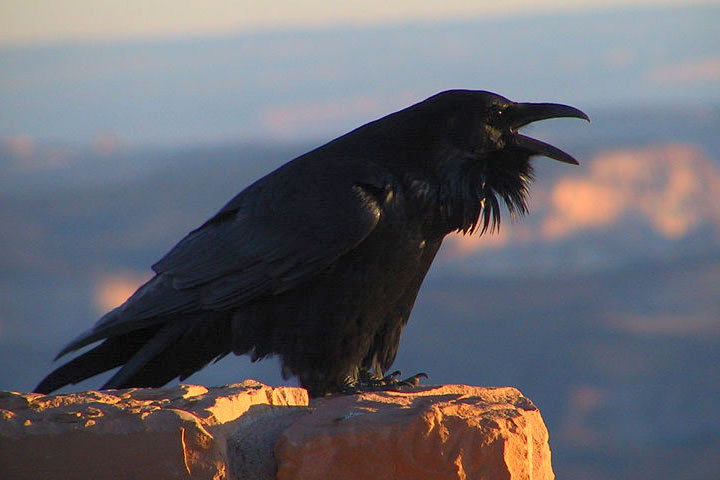

What is the difference between a raven and a crow? Ravens differ from crows in appearance by their larger bill, tail shape, flight pattern and by their large size. Ravens are as big as Red-tailed Hawks, and crows are about the size of pigeons. The raven is all black, has a 3.5-4 ft wingspan and is around 24-27 inches from head to tail. The crow is also black, has a 2.5 ft wingspan and is about 17 inches long. The raven weighs around 40 oz while the crow is 20 oz - half the weight of a raven. The raven has highly glossed plumage showing iridescent greens, blues, and purples. Sometimes the feathers have an oily or wet sheen. Crows also have feathers with iridescent purple and blue, but with less sheen than the raven. Ravens are uncommon in populated urban areas. If you see a "really big crow" in the city, the chances are good that it really is a crow and not a raven. Ravens have wedge-shaped tails and crows have fan-shaped tails (view drawing). 
Ravens are longer necked in flight than crows. The larger bill of the raven can be seen in flight, but it is less apparent than the long neck. Raven wings are shaped differently than are crow wings, with longer primaries ("fingers") with more slotting between them. Ravens have pointed wings, while crows have a more blunt and splayed wing tip. A raven's wing sometimes makes a prominent "swish, swish" sound, while a crow's wingbeat is usually silient. Ravens soar more than crows. If you see a "crow" soaring for more than a few seconds, take another look - it might be a raven. Common Ravens can do a somersault in flight and even fly upside down. Ravens are longer necked in flight than crows. The most familiar call of a raven is a deep, reverberating croaking or "gronk-gronk." Crows make the familiar "caw-caw," but also have a large repertoire of rattles, clicks, and bell-like notes.
Common ravens have a well-developed ruff of feathers on the throat, which are called 'hackles' while the feathers on the throat of a crow are smooth. VocalizationsRaven Calls: The common raven makes a variety of calls including these sounds: "croooaaak", "cr-r-ruck", "tok", and "wonk-wonk." Listen to calls of this species » Crow Calls: The normal crow call is a loud caw or awk. The call is often vocalized in a short series - "caw caw caw." They also produce a variety of rattles, coos, and clear notes. Listen to calls of this species » Range and Habitats:
Note that ravens are found throughout the state, except for large urban areas including Seattle, Bellevue, Tacoma, Olympia, and Vancouver. Crows are common in most open habitats near populated areas. Click on the range map for more information on the distribution of ravens and crows in Washington.
Facts:
More information: Crows - WDFW Living with Wildlife Crow vs. Raven Podcast - NatureWatch Frequently Asked Questions about Crows - Cornell University References: Heinrich, B. 1989. Ravens in Winter. Simon and Schuster, New York. 601pp. Heinrich, B. 1999. Mind of the Raven. Harper Collins, NY, pp380. Stahler, D.R., B. Heinrich and D.W. Smith. 2002. The Ravens' Behavioral Association with Wolves. Animal Behaviour 64:283-290. Photos: Lantz; Tim Knight; Natures Pics Home | About Us | How to Participate | Biodiversity Modules | Projects | Maps | News | Resources |